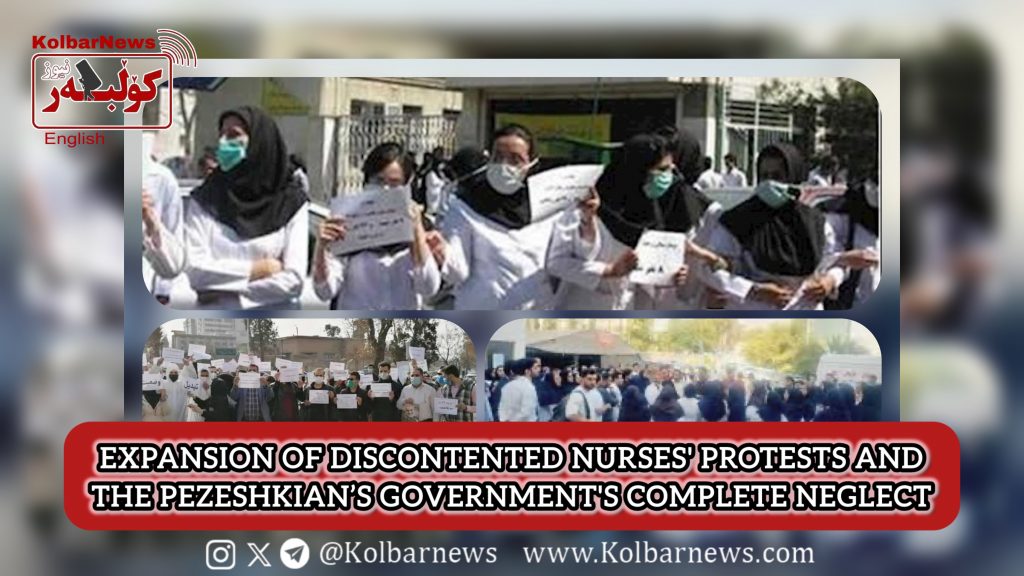
Het Nearly two weeks have passed since the new wave of nationwide protests by nurses in various parts of Iran, and so far, their cries and slogans have not received any attention from the regime’s officials. This round of protests began with nurses in Karaj and hospitals in Alborz Province, then spread to hospitals in Fars Province, and later to other regions such as Zanjan and the northern provinces. On August 17, nurses at two major hospitals in Mashhad also went on strike, joining the protesting nurses in other cities across Iran. According to a reporter from the state news agency ILNA, the nurses are chanting slogans like: “Enough with the promises, our tables are empty,” “Where are our tariffs? In your pockets!” and “We fought COVID, got no support.”
In the past ten days, neither the new president nor his appointed deputies have responded to the nurses’ protests. One of the protesting workers told ILNA, “We expected the new president, who is himself a doctor, to at least send a representative to talk with the nurses and understand what’s going on.”
Mohammad Sharifi Moghaddam, the Secretary-General of the House of Nurses, explained to ILNA why the nurses have resorted to nationwide protests: “It’s been nearly two weeks since the national protest of nurses began. This strike and work stoppage is unprecedented. We’ve held sit-ins and protests before, but never has a strike lasted this long. The reason is that instead of addressing the reality, they tried to sweep it under the rug by summoning protesting nurses to disciplinary committees and putting pressure on them, which only led to accumulated demands and dissatisfaction.”
Currently, 220,000 nurses are working in the healthcare and hospital sectors, over 90% of whom are dissatisfied and receive minimal wages and benefits. Sometimes, even these meager wages are not paid on time. In addition to low pay and benefits, one of the main causes of dissatisfaction is the overwhelming workload. There is a shortage of more than 100,000 nurses in Iran, while about 20,000 trained nurses are unemployed. Instead of hiring new staff, the remaining work is imposed on the employed nurses as overtime.
Many nurses are forced to take extra shifts to compensate for the lack of staff, yet they do not receive standard compensation. This, combined with the challenging nature of the job, leads to increased burnout and a higher risk of disability. The hardship law, which was passed for nurses, is not being implemented. According to this incomplete law, nurses can retire after 20 years of service, are entitled to two months of paid leave annually, and should receive a hardship pay increase. However, given the current situation, it seems unlikely that these benefits will ever materialize, which is one of the points of contention for the nurses.
All these hardships, which are imposed on healthcare workers and nurses even in normal conditions, became much more severe during the COVID-19 pandemic. In addition to enduring exhausting work, nurses were also at risk of contracting the virus, and dozens of them lost their lives, though their numbers were never made public.
To confront these unbearable living, political, and social conditions, nurses primarily protest and struggle. However, those who can, seek to emigrate. According to available statistics, nearly 3,000 nurses leave Iran each year. Trained nurses migrate to Gulf countries, European countries, Australia, Canada, and the United States. These countries offer better wages and regulate workloads, making conditions more favorable for experienced and educated nurses.
Statistics published in domestic newspapers indicate a sharp increase in the emigration of doctors and nurses, despite travel restrictions. Over the past four years, more than 10,000 trained doctors and nurses, including general practitioners, specialists, and subspecialists, have left Iran. According to statistics presented by the newspaper Farheekhtegan, in 2023 alone, 2,300 specialists and 4,200 general practitioners left Iran, which is 30% higher than the average entry of doctors into the Iranian job market.
However, nurses who have no choice but to continue protesting and organizing within Iran remain active in the struggle. Over several years of protests, they have established networks that enable them to coordinate simultaneous protests in multiple cities, voicing their common demands.
There is no doubt that the accumulation of demands from nurses, workers, retirees, and other disadvantaged groups, coupled with the regime’s inability to address them, provides fertile ground for mass uprisings and a suitable environment for society to move toward a final resolution with this regime.

